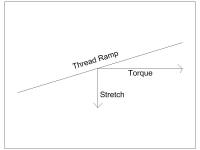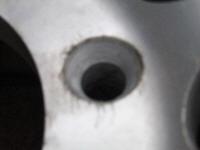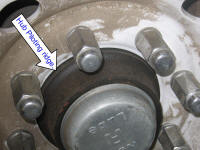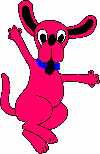 |
 |
 |
Last Changed 3/23/2009
|
Loose wheel lug nuts create a very dangerous condition. There is
the extreme chance that if driven long enough, the lug nuts could
come off of the hub studs and the wheel rim could come off the
axle. More likely, the wheel rim, loose on the hub, will wear the
hub studs, causing them to fail. Tight lug nuts is especially
important to trailer where the wheels are subjected to more
side loads from turns during parking.
Aside from the risk of loosing a wheel, the probable outcome of the
wheel rim being loose on the hub, is a lot more flexing of the tire
carcass, causing heat and breakdown of the tire.
No matter the result, loose lug nuts is a very bad condition. There
is a lot of misunderstanding about torque and wheel lug nuts.
Many believe that if the lugs nuts are loose, then enough torque was
not applied to the lug nuts. This is not true. In fact, over
torqueing can be part of the reason for the loose lug nuts. More
importantly, over torqueing lug nuts can over stretch the hub studs and
lead to the failure of the studs.
|
 |
First a little background. The threads on the hub stud and in the
lug nut are actually ramps wrapped around in a circle. When torque
(twisting force) is applied to the lug nut, the rising of the ramp
causes the stud to be stretched. This stretch is what causes the
lug nuts to stay tight. The stretched stud is like a spring and
pulls the nut towards the hub holding the wheel rim tight. |
Wheel hub types
There are basically two types of wheel hubs determined by how the wheel is centered on the hub.
|
 |
Stud piloted wheels have tapered stud holes
and the lug nuts have a matching taper. The centering of
each lug nut in the stud hole of the wheel will cause the
wheel to be centered on the hub. The hub hole in the wheel
only serves to allow hub clearance. |
 |
Hub piloted wheels use the center hole of
the wheel to fit over the matching size ridge on the hub.
The wheel is centered on the hub by the hub hole. The lug
nuts will have a flush face in contact with the wheel. The
lug nuts only secure the wheel to the hub.
Since the hub piloted wheels use the hole for centering the
wheel, the lug nuts only have to hold the wheels tight. |
Click on images to enlarge |
 |
Hub Piloted Wheel (lower example):
The wheel hub hole and the centering ridge of the hub mate
and the wheel is centered. the stud nuts only have to hold
the wheel against the hub.
Therefore, the best thing for hub piloted wheels is to
re-torque the lug nuts after a few miles of travel. Once
should be enough. |
 |
Hub Piloted Wheel (upper two examples):
Stud piloted wheels have a greater opportunity to not being
centered when first put on. There are 5-8 studs and all of
them have to be centered for the wheel to be settled. In an
ideal situation, when you first put the wheel on, the lug
nuts should be finger tight and then spin the wheel to allow
it to settle. This is also why you should apply torque to
the lug nuts in a star pattern as that helps the wheel to
settle. |
|
In reality, especially with the weight of the wheels we have on our
RVs, you will probably have to use a wrench just to get the lug
nuts seated and spinning the wheel will probably be out of the
question.
The chance of a lug nut not being fully seated could result in a
condition like the center drawing in the picture above. You can
apply full torque and the nut will not seat. You can over torque
the lug nuts and still not seat the lug nut that is off center.
Again, driving down the road will allow the wheel to settle. Again,
the best thing is to torque the lug nuts, drive a bit, and re-torque
the lug nuts. A couple of times would be appropriate for stud
piloted wheels.
When I was in the ARMY, I saw truck drivers use a three foot breaker
bar and stand on the bar to torque the lug nuts on a truck (several
hundred pounds of torque) and fail inspection the next day with
loose lug nuts. I would use the torque wrench, drive the truck down
the runway, and re-torque until the nuts were found to not be
loose. After that, the nuts stayed tight until the next time the
wheel needed to be removed.
Over torqueing is done every day on wheel studs. Each size stud has
an appropriate torque. That torque will stretch the stud the amount
necessary to keep the lug nut from turning.
If you over torque, you over stretch the stud and weaken it.
Even using a torque wrench you can over-torque a stud. Once a lug
nut has reached the proper torque, if you use the torque wrench
again, the clicking action of a snap torque wrench will apply a
slight amount of over-torque. Click enough times and you are
over-torqueing the stud. So the next time you see a mechanic using a
air/electric power nut driver, and he applies power until the
clicking limit is reached several times, you just watched a stud
being stretched.
There are torque wrenches that use a bending indicator that do not
increase the torque when you check the torque level. The snap torque
wrenches work without your having to look at it when torqueing. The
objective is to torque the lug nut until the wrench snaps. One snap
is enough.
Lubricating the Threads
Some people like to put lubricant on the threads so that they are
easier to remove. You actually make things worse doing that. With
lubricant on the threads, you can put more stretch into the stud
with the same amount of torque. The lubricant will eventually
evaporate and when you go to remove the lug nut, you have the extra
stretch tension to break loose.
Likewise, if the threads are cruddy, that can induce more friction
and cause the stud to not be properly stretched.
When torque values are given, they are for dry threads.
Torque Values
| Sample Torque Values |
| Stud Size | Torque |
| 3/8" (fine) | 35-45
lbs.-ft. |
| 7/16" - 18 (fine) |
50-60 lbs.-ft. |
| 12 mm - 1.5 (fine) |
70-80 lbs.-ft. |
| 1/2" - 20 (fine) |
80-90 lbs.-ft. |
| 5/8" - 18 (fine) |
110-125 lbs.-ft. |
| 5/8" - 13 (course) |
110-125 lbs.-ft. |
|

